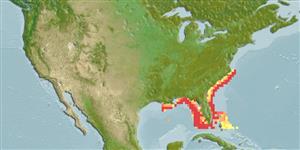Issue
Type locality: southern Florida and Pensacola, Florida.
Environment: milieu / climate zone / depth range / distribution range
Ecología
marino demersal; rango de profundidad 25 - 183 m (Ref. 5222), usually 60 - 120 m (Ref. 5222). Subtropical; 36°N - 24°N, 98°W - 62°W (Ref. 5222)
Western Atlantic: Bermuda and the coast of the USA from North Carolina to the Florida Keys and in the northern and eastern Gulf of Mexico. Reports from Cuba and the Bahamas are unsubstantiated.
Tamaño / Peso / Age
Maturity: Lm ? range ? - ? cm
Max length : 110 cm TL macho / no sexado; (Ref. 5222); peso máximo publicado: 30.0 kg (Ref. 5222); edad máxima reportada: 45 años (Ref. 93919)
Espinas dorsales (total) : 11; Radios blandos dorsales (total) : 15 - 16; Espinas anales: 3; Radios blandos anales: 9.
Inhabits offshore rocky bottoms; most common between 60 and 120 m.
Life cycle and mating behavior
Madurez | Reproducción | Puesta | Huevos | Fecundidad | Larva
Heemstra, P.C. and J.E. Randall, 1993. FAO Species Catalogue. Vol. 16. Groupers of the world (family Serranidae, subfamily Epinephelinae). An annotated and illustrated catalogue of the grouper, rockcod, hind, coral grouper and lyretail species known to date. Rome: FAO. FAO Fish. Synop. 125(16):382 p. (Ref. 5222)
IUCN Red List Status (Ref. 130435: Version 2024-2)
Threat to humans
Harmless
Human uses
Pesquerías: comercial; pesca deportiva: si
Herramientas
Special reports
Download XML
Fuentes de Internet
Estimates based on models
Preferred temperature (Ref.
123201): 17.7 - 25.2, mean 22.1 °C (based on 19 cells).
Phylogenetic diversity index (Ref.
82804): PD
50 = 0.5000 [Uniqueness, from 0.5 = low to 2.0 = high].
Bayesian length-weight: a=0.01122 (0.00659 - 0.01911), b=3.04 (2.90 - 3.18), in cm total length, based on LWR estimates for this species & Genus-body shape (Ref.
93245).
Nivel trófico (Ref.
69278): 4.0 ±0.6 se; based on size and trophs of closest relatives
Resiliencia (Ref.
120179): Bajo, población duplicada en un tiempo mínimo de 4.5-14 años (K=0.13; tmax=25).
Fishing Vulnerability (Ref.
59153): High vulnerability (62 of 100).
Nutrients (Ref.
124155): Calcium = 33.9 [14.0, 78.6] mg/100g; Iron = 0.783 [0.376, 1.829] mg/100g; Protein = 18.5 [16.8, 20.0] %; Omega3 = 0.292 [0.160, 0.530] g/100g; Selenium = 38.1 [17.9, 90.0] μg/100g; VitaminA = 19.9 [4.7, 83.9] μg/100g; Zinc = 0.705 [0.451, 1.142] mg/100g (wet weight);
